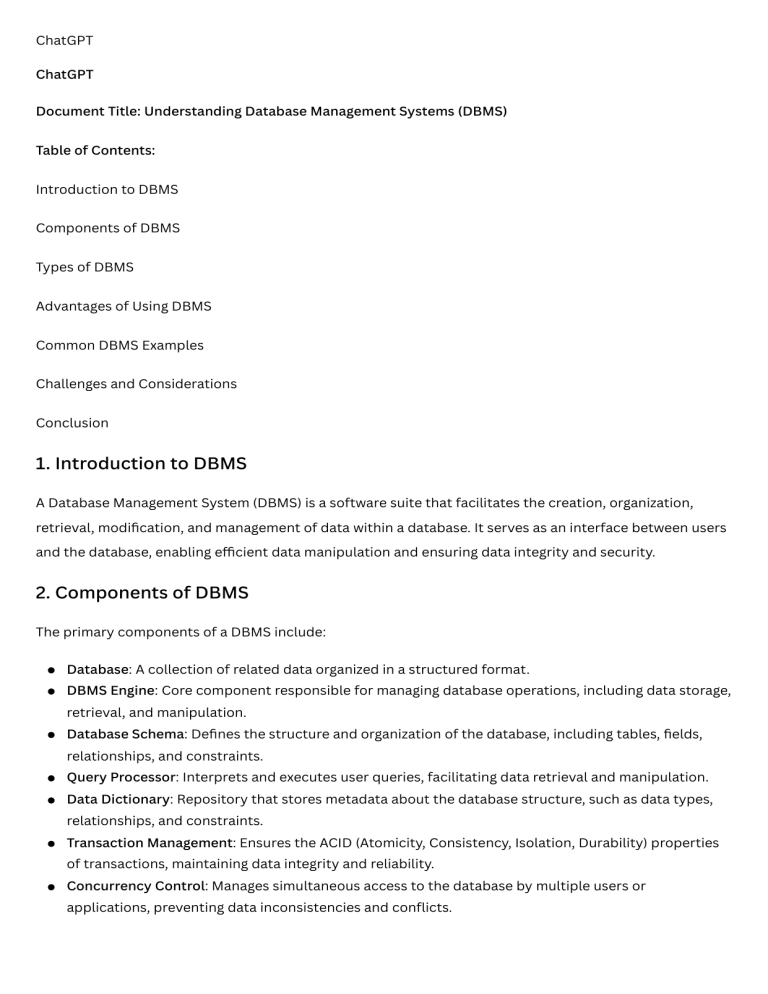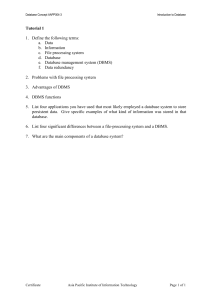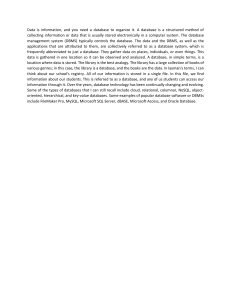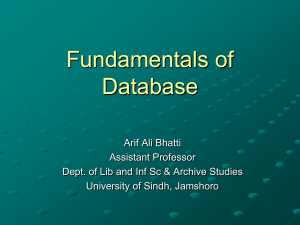
ChatGPT ChatGPT Document Title: Understanding Database Management Systems (DBMS) Table of Contents: Introduction to DBMS Components of DBMS Types of DBMS Advantages of Using DBMS Common DBMS Examples Challenges and Considerations Conclusion 1. Introduction to DBMS A Database Management System (DBMS) is a software suite that facilitates the creation, organization, retrieval, modification, and management of data within a database. It serves as an interface between users and the database, enabling efficient data manipulation and ensuring data integrity and security. 2. Components of DBMS The primary components of a DBMS include: Database: A collection of related data organized in a structured format. DBMS Engine: Core component responsible for managing database operations, including data storage, retrieval, and manipulation. Database Schema: Defines the structure and organization of the database, including tables, fields, relationships, and constraints. Query Processor: Interprets and executes user queries, facilitating data retrieval and manipulation. Data Dictionary: Repository that stores metadata about the database structure, such as data types, relationships, and constraints. Transaction Management: Ensures the ACID (Atomicity, Consistency, Isolation, Durability) properties of transactions, maintaining data integrity and reliability. Concurrency Control: Manages simultaneous access to the database by multiple users or applications, preventing data inconsistencies and conflicts. Backup and Recovery: Mechanisms for backing up data and restoring it to a consistent state in case of failures or errors. Security and Authorization: Implements access control mechanisms to secure data and restrict unauthorized access to sensitive information. 3. Types of DBMS There are several types of DBMS, including: Relational DBMS (RDBMS): Organizes data into tables with rows and columns, using structured query language (SQL) for data manipulation. Examples include MySQL, Oracle, and PostgreSQL. NoSQL DBMS: Supports flexible data models and non-relational data structures, suitable for handling large volumes of unstructured or semi-structured data. Examples include MongoDB, Cassandra, and Redis. Object-oriented DBMS (OODBMS): Extends relational database concepts to support complex data types and object-oriented programming principles. Examples include db4o and ObjectDB. NewSQL DBMS: Combines the scalability of NoSQL systems with the ACID compliance of traditional RDBMS. Examples include Google Spanner and CockroachDB. 4. Advantages of Using DBMS Improved data organization and management Enhanced data security and integrity Efficient data retrieval and manipulation Support for concurrent access and transaction management Scalability and flexibility to handle diverse data types and workloads 5. Common DBMS Examples MySQL: An open-source RDBMS widely used for web applications and enterprise solutions. Oracle Database: A comprehensive RDBMS offering advanced features for large-scale data management. MongoDB: A popular NoSQL database known for its flexibility and scalability, suitable for handling big data and real-time applications. 6. Challenges and Considerations Data Security: Protecting sensitive information from unauthorized access and data breaches. Performance Optimization: Ensuring efficient data retrieval and processing to meet performance requirements. Data Integrity: Maintaining the accuracy, consistency, and reliability of data within the database. Scalability: Adapting the database to accommodate growing data volumes and user demands. Cost and Licensing: Considerations related to the acquisition, deployment, and maintenance costs of DBMS solutions. 7. Conclusion DBMS plays a crucial role in modern data management, providing organizations with the tools and capabilities to effectively store, organize, retrieve, and manage data. By understanding the components, types, advantages, and considerations of DBMS, businesses can make informed decisions when selecting and deploying database solutions to meet their data management needs.




